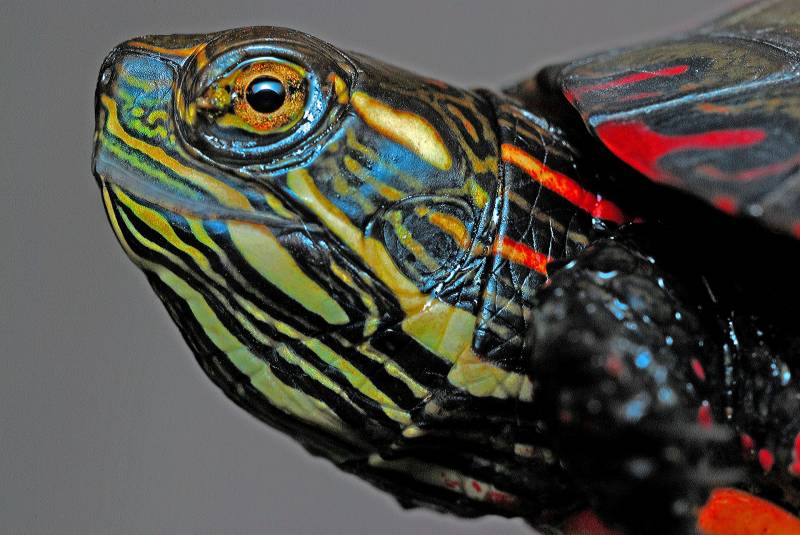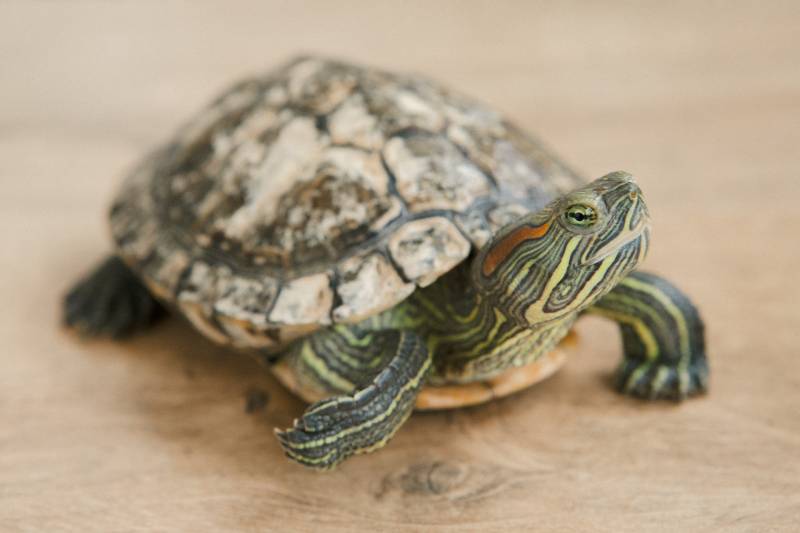Quick Navigation
- More Than Just A Shell
- Hard Yet Spongy
- Give Me The Sunshine
- Feeling The Heat
- Hitting A Nerve
- Puncture Wounds
- Natural Defenses
- Breathing Problems
- Suppressed Growth
- Is There A “Safe” Way to Paint A Turtles Shell?
- Can A Painted Turtle Shell Be Cleaned?
- What Can I Use As An Identification Mark For A Turtle?
- How To Be Creative With Your Turtle Without Using Paint?
- Conclusion
Turtles make great pets, and if you are an artsy owner, you may wonder if you can paint a turtle shell.
Turtles are also easy to handle and don’t require much space or upkeep.
The defining feature of a turtle – its shell – is a fantastic creation of nature that instantly inspires awe and amazement.
A turtle’s shell is usually covered in intricate patterns, but you’ve probably noticed that they aren’t too vibrant or colorful!

But if you want to add a bit of color and make your pet look pretty or put on an identifying mark for scientific purposes, most experts advise against painting a turtle’s shell.
You’ll be surprised to know the reasons.
Read on to find answers to your question if you can paint a turtle shell.
More Than Just A Shell
A turtle’s shell is more than just its home.
It’s a part of the turtle’s skeleton and houses the complete internal organs of the animal.
A turtle’s shell comprises two pieces or plates of modified skeletal bones that form a covering for the internal organs.
This means that the shell protects a turtle’s internal organs and fulfills several functions directly related to the turtle’s health.
Hard Yet Spongy
Contrary to what appears to the naked eye, a turtle’s shell is not completely sealed off from the outside environment.
The shell is “porous,” which means it can absorb liquids and other materials into the central cavity of the body.
So, if you paint the shell, any harmful chemicals present in the paint can make their way into the turtle’s body and cause serious health problems.
Give Me The Sunshine
Just like humans absorb UV light from the sun through their skin, a turtle uses its shell to soak up their much-needed sunshine!
A turtle’s shell absorbs UV light from the sun and uses it to make vitamins that are ESSENTIAL for the animal’s health.
If you paint over the shell and cover it up, the turtle won’t absorb sunlight and will suffer from several possible diseases due to the lack of necessary vitamins.
Feeling The Heat
A turtle’s shell also enables the animal to regulate its body temperature, much like sweating with humans.
Along with absorbing UV rays, the turtle’s shell keeps the internal temperature constant and helps trap heat from the sun to keep the turtle healthy.
Covering the shell with paint can cause the turtle to heat up internally, leading to serious health complications.
Hitting A Nerve
A turtle’s shell isn’t just bone!
It contains hundreds of nerve endings, meaning the turtle can FEEL its shell!
Harmful chemicals in paint can highly damage the nerve endings in a turtle’s shell.
It could also cause pain and discomfort to your turtle.
The turtle may also feel like it is “suffocating” due to the nerve endings triggered by the paint.
It may lead to immense long-term discomfort and health issues for the turtle.
Puncture Wounds
Because a turtle’s shell is part of its skeleton and houses its internal organs, any damage to the shell, like a puncture or wound, can lead to infections and disease.
And even though it may seem that painting the shell is a relatively harmless process, the chemicals in the paint can erode the shell and damage its cells over time.
This may lead to a much higher risk of infection and even death.
Natural Defenses
A turtle’s shell is part of its natural defense against predators.
The muted colors of the shell are perfectly adapted to help the animal blend into its natural habitat and stay safe from the prying eyes of predators.
If you paint the turtle’s shell bright, you eliminate its defense and make the turtle stick out like a sore spot amidst its natural habitat.
A bright color also makes them easier for predators to spot them.
And because some turtle species are endangered or require preservation and protection.
Turtles decrease their chance of survival in the wild if predators can easily find them.

Breathing Problems
As mentioned before, a turtle’s shell is porous. It means that it can absorb liquids.
Breathing issues are a severe consequence of toxic chemicals being absorbed by the turtle’s shell.
The irritants and chemicals in the paint directly affect the turtle’s lungs, making it hard for the animal to breathe!
It can cause suffocation, infections, and other diseases over time, causing a rapid decline in their health.
Suppressed Growth
Because a turtle’s shell is made of living tissue and bones, it grows as the animal matures.
Contrary to popular belief, a turtle or tortoise DOES NOT change its shell after some time.
Instead, their shell naturally grows and adapts to their changing body as time passes.
Therefore, if you paint a turtle’s shell, you can seriously affect its natural growth, causing abnormal deformities and irregularities.
The turtle may eventually suffer severe problems because the damaged shell will not grow properly to accommodate its organs as it matures.
Painting a turtle’s shell may lead to impeded movement, stunted growth, and adverse health conditions.
Is There A “Safe” Way to Paint A Turtles Shell?
The short answer is NO.
Most common paint types are not suitable for a turtle, even though they may be labeled “non-toxic.”
This is because no matter what paint you use, the effects will be the same!
As all paints create a layer over the shell, the hazards remain the same for all types of paint, including acrylic paints, sharpies or markers, oil-based paint, powdered pigments, wax-based colors, marker, or paint.
The only RELATIVELY safe way to paint a turtle’s shell is to use water-based paints that can easily wash off!
Any permanent paint or marking on a turtle’s shell can cause lasting damage.
Even if you use water-based paints to mark your turtle temporarily, it is still strongly discouraged, and we suggest you avoid this practice.
If you really insist on painting the shell of your turtle pet, you are actually not doing it any favors, regardless of the material you intend to use.
While it may seem harmless to you, painting their shells does more harm than good.
So be mindful of what you want to do with your turtle.
It’s way better for your turtle to enjoy its life instead of being miserable just because you want to see it painted up.
Can A Painted Turtle Shell Be Cleaned?
You need specialized care when cleaning a painted turtle shell to avoid damage.
Best is to see a vet if you wish to clean off a painted turtle shell.
Using common household chemicals, detergents, laundry/washing liquids, or soap is unsuitable for turtles, and you may end up causing them more harm!
Cleaning a turtle’s shell usually requires multiple washing sessions and is best handled by a certified vet or animal healthcare professional.
What Can I Use As An Identification Mark For A Turtle?
Painting a turtle’s shell is a common practice for identification purposes.
But because you are generally discouraged from painting a turtle’s shell, you can use alternative methods to aid identification.
The specialized process called notching is done by drilling a small hole at a specific spot on the turtle’s shell.
Notching requires intimate knowledge of the animal’s physiology.
Therefore, only a trained vet should perform notching.
Using Tags
An easy method that you can use to mark your turtle for identification purposes is to use flipper tags that a vet can attach temporarily.
Another easy way is to use RFID chips called PIT tags.
A PIT tag is the size of a rice grain, and a specialist embeds it under the turtle’s skin.
Consult your vet for other safe methods for identification, tagging, and marking your turtle.
Natural Identifiers
An excellent method that requires no particular procedure which you can use for keeping track of your turtle is to make imprints of the turtle’s shell pattern using paper and crayon or to use easily visible markings on the shell.
How To Be Creative With Your Turtle Without Using Paint?
If you want to decorate your turtle, you can dress it up.
Just ensure that you let it wear clothes made of breathable fabric, lightweight, and loose-fitting.
You can even source these materials from a local shop and sew them yourself.
If your turtle shows some signs of distress when you dress it up, be responsible enough to remove it from your turtle.
Because, as logic tells us, turtles aren’t really meant to wear clothes as humans do.
But if your turtle is okay with it, ensure that you have to take it off after a while.
Conclusion
Imagine having a hard coat of paint covering your entire body.
It’s pretty easy to understand how uncomfortable and harmful that would be for us!
It will be the same for your turtle if you paint its shell.
It creates discomfort for the animal and leads to serious health complications.
So even though you might be tempted to follow along with tradition or something you saw online, leaving the turtle’s shell in its natural state is better.
Help the animal lead a healthy life!

Purrfect n’ Pawesome is the brainchild of Amanda, who has been into researching and writing about pets to help other pet parents in nurturing their adorable pets. Currently, she runs Purrfect n’ Pawesome along with her team of experienced and dedicated pet experts. Along with being an awesome writer and entrepreneur, Amanda is a cat mom to two innocently spoiled cats, Balanca and Scruffy.
She has been writing about pet care and nurturing and wants to share her readers’ experiences, learnings, and knowledge.
Over the years, she had the opportunity to work with various pet owners having multiple breeds, and that exposure gave her experience and the lessons of a lifetime.
Her family, her entire universe revolves around her two cats, who give her endless support and inspiration to move ahead with her objectives in life. Amanda is a live example of a balanced approach to all parenthood questions we all face in life.


